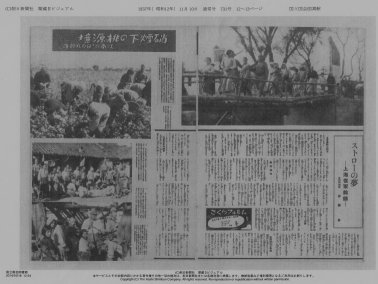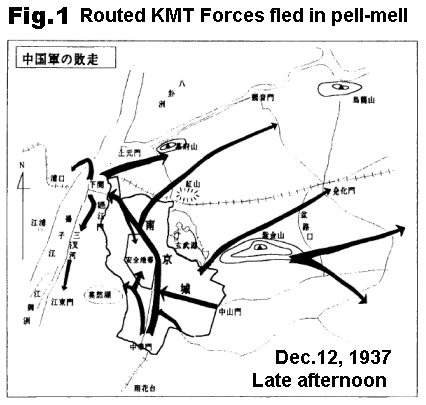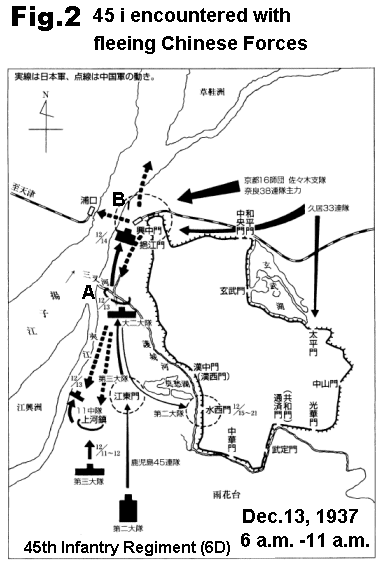The Lies of gThe Rape of Nankingh by Iris Chang
Last Update: October 28, 2015
Moguro Fukuzo
The author considers that gThe Rape of Nanking: The Forgotten Holocaust of World War IIh by Iris Chang is total fabrication and mere collection of lies. The author will show you what kinds of tricks are contained in the book to deceive you.

Example 1 Rounding-up or Escorting?
The following photo appears within the photo gallery pages of the book.

Soon after the book was first published in 1997, a Japanese historian noticed that the photo was taken from the November 10, 1937 edition of the ASAHI-GRAPH. The original photo looks like this.
 |
 |
Nov.10, 1937 edition of the ASAHI-GRAPH |
When you augment a part of the photo, you may notice the facial expressions of the people. It seems that some of them are smiling. From these faces, can you read the fear of being rounded-up for gang rapes or forced prostitution?
The caption of the ASAHI-GRAPH photo says,
gHeaven under the gun smoke: Chinese farmers of the Hinomaru Village cheerfully go back home from their crop fields under the protection of our troops. The photo was taken by our company's expatriate reporter Kumazaki in Baoshan District near the Yangtzi River.h
Compare the wording with that of the Rape of Nanking photo.
The following photos were also taken by the same reporter Kumazaki in the same "Baoshan District near the Yangtzi River." These photos belong to the same section titled as Special Report: Hinomaru Village, which seems to be the village under the control of the Japanese Army as you see the flag in the middle of the village. Notice that the Japanese soldiers are present not only in the village but also in the crop fields.
Therefore, the above photo obviously shows the Japanese Army soldiers escorting the villagers going to and coming from the crop fields.
As the kanji-letters clearly suggest, the "Baoshan District near the Yangtze River" should be the following place. It seems that, after the Battle of Shanhai and prior to the Fall of Nanking, the Japanese soldiers provided protection for the local people from disbanded, demoralised loaming bandits. (Surely, many of the bandits should have been Chinese KMT soldiers defeated in the Battle of Shanhai. )

Summation of the Example 1
Therefore, from the analysis above, we can reach the following conclusions:
gThe Politburo of Military Committee, Taipeih deliberately:
- obscured the facial expressions of the people in order to hide their relaxed feelings;
- cut the portion showing a woman pulling a cart and following the other villagers willingly;
- changed the wording of the caption to give the photo a totally different meaning.
Iris Chang used the modified photo in her book. This is what you call A LIE and/or DECEPTION.
The author strongly believes that any photo which does not give you the basic description to identify the name of the photographer, when and where the photo was taken, has no value at all.

Further Comment
It is a common mistaken notion that the Chinese soldiers, regardless of whether they belong to Chiang Kai-sukfs KMT Forces or Maofs PRC forces, were well-disciplined good soldiers and, on the other hand, the Japanese Imperial Army officers were brutal killers.
On the contrary, if you look into the history carefully, the Chinese Army, any army of any period of its long history, caused total destruction of a city and mass-killing of people before the army occupies the city. When the army leaves the city, it would cause another total destruction and mass-killing of people. Since Chinafs Armies are all privately-owned armies, the soldiers rarely fight for their nation, but often for themselves. Even today, China's PRC forces are considered to exist for the protection of the Chinese Communist Party, not the nation. As they are not financed by the nation, they earn payment by depriving property of the citizens. Rapes and murders become their appetite when they take or leave a city. That was the horror the Japanese Army encountered as they advanced deep into the Chinese Continent. You can see Chinafs uncivilized chaotic brutality in todayfs Uyghur and Tibet. They are no saints.
History reveals that the occupied territory of the Japanese Army was the most secure, safe places to live. Once the battle was over, the law and order were quickly recovered.
China in 1937 was no peaceful land boasting of its bounty either. Great famines occurred in many places that would kill hundreds of thousands of people. Warlords fight each other in an attempt to get hegemony over others.
You should not judge such land of the Wild West where Quantrill and his loaming bands were everywhere, with todayfs values.

Example 2 Japanese Soldier Kills Someone in Summer
The following photo appears within the photo gallery pages of the Rape of Nanking by Iris Chang.
Notice that the man who is beheading the victim wears a half-sleeve shirt. It is definety early or mid-summer.
(The victimfs head is not detached from his body anyway.)

Compared to the above, see the following winter situation.
The City of Nanking fell to the hands of the Japanese Army on December 13, 1937.
The following photo was taken on January 25, 1938, which demonstrates the accomplishment of the Japanese Army rarely told in history;
No one in the city of Nanking died of starvation during the Japanese Army's occupation of the city.

The Japanese Central China Army comprises a) Shanghai Expedition Army and b) the 10th Army.
The 10th Army left Nanking by the end of December for occupation of Hanzhou iYBj.
The Shanghai Expedition Army left Nanking by the end of January, 1938, to prepare for the Battle of Xuzhou iBìíj.
The 16th Division of the latter remained for a while (45 days to be exact) until early February, but followed the others leaving a small unit for the assistance of the newly established government.
Therefore, the photo showing a soldier beheading a person in summer is hoax.

Example 3 Porn or Rape ?
The following photo appears within the photo gallery pages of the Rape of Nanking by Iris Chang.
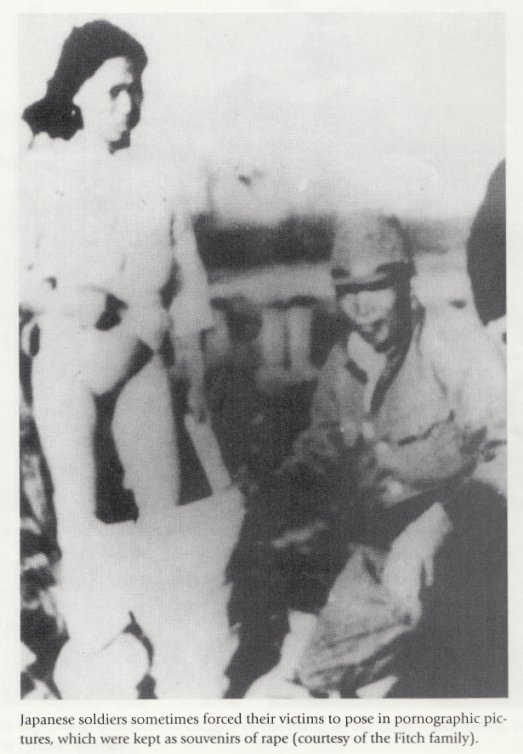
This Iris Chang Photo seems to have taken from the right one, which is placed in the book titled gSØ@Rh
(literal translation is gThere is a pile of sure evidences like a mountainh) published in Taiwan.
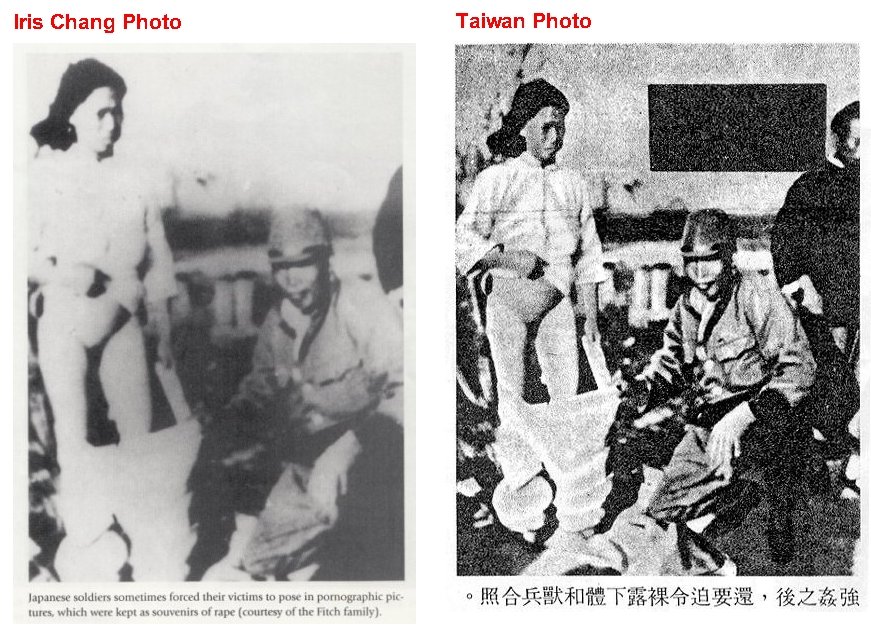
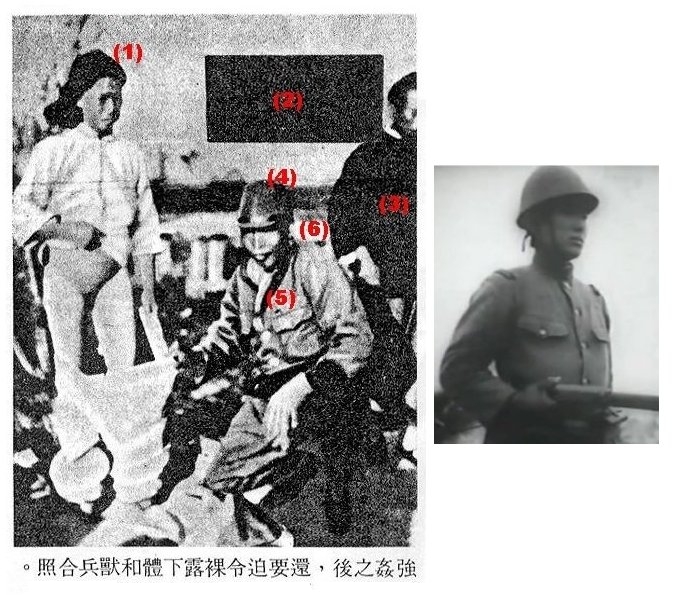
With this Taiwan Photo, you may notice that:
(1) The woman wears a wig;
(2) Part of the wall behind is blacked out and that part was erased in the Iris Chang Photo;
There must have been something the photographer wanted to hide there. The name of the brothel or the photo studio ?
(3) A Chinese man appears. This part was cut-out in the Iris Chang Photo;
(4) The soldier wears a helmet which is quite different from the one distributed to the Japanese soldiers. (Compare it to the standard uniform of a Japanese soldier to the right);
(5) The soldier wears the shirt rather sloppily;
(6) The shirt has no shoulder marks. The shirt should be a plain cloth, not the army uniform. Therefore, the "soldier" should be Chinese.
With the assumptions above, the Iris Chang Photo must be one of the pornographic photos
circulated among soldiers. It has nothing to do with rape.
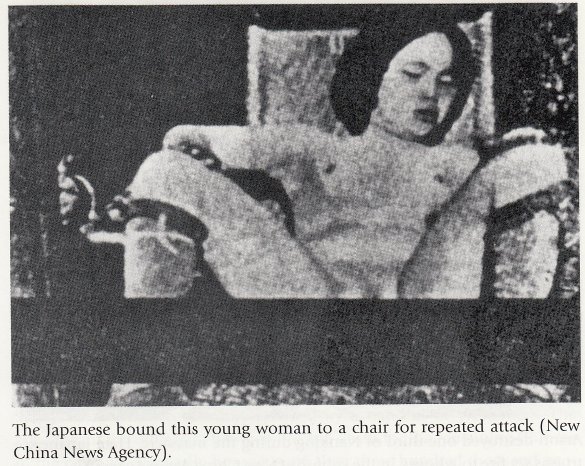 |
This photo also appears inside the Iris Chang book.
Can you call it an authentic evidence of the rape by the Japanese Army? Is it a joke?
If so, you should gather all porn photos provided in the U.S. and call them the authentic evidences of rapes committed by American males.
|

Example 4 Smiling Officer with Strange Heel
The following photo appears within the photo gallery pages of the book.
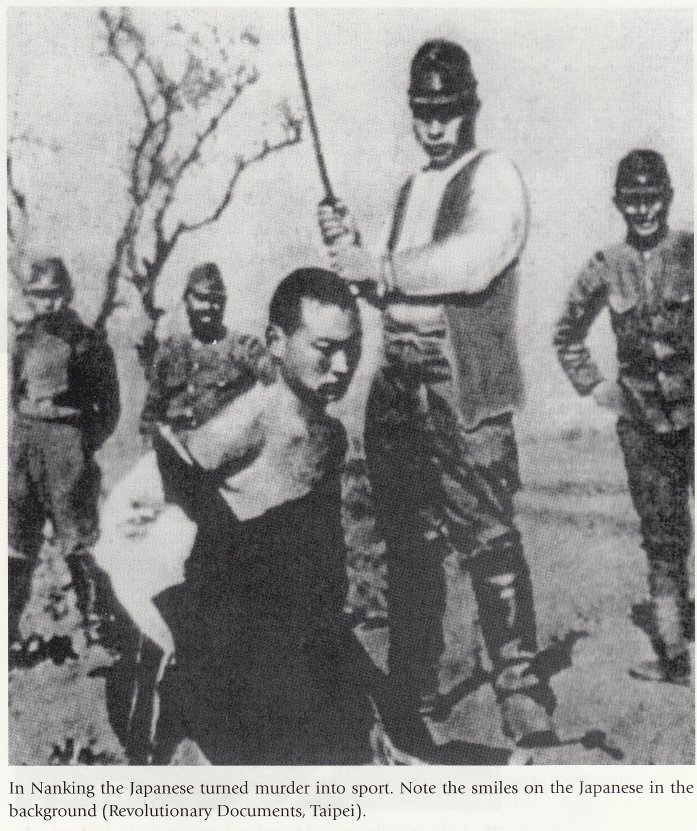
You may notice the following points.
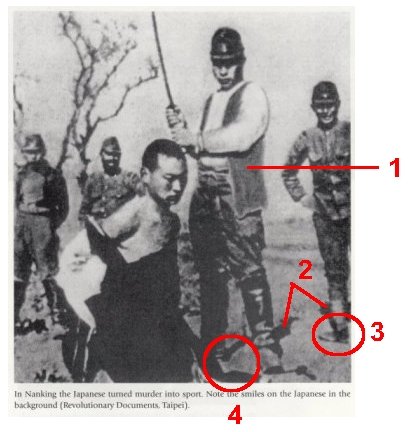 |
- This vest looks very strange. No one in the Japanese Army wears this type of the vest, irrespective of officers or soldiers.
- The directions of the shadows are not parallel, but contradictory. From where does the sunlight cast these shadows?
- His toe is in abnormal direction.
- There is no shadow of the victim, although the other two men have it in sunlight.
- The photographer is very close to the gsport-killh scene. You would wonder in what situation the photographer was allowed to take this photo.
|
The author considers that this photo is a patchwork created from different photos.

Example 5 Selling Old Cloths in the Middle of the Mass Murder
The following photo appears within the photo gallery pages of the book.

This photo is also used in Annex II of gBattle of Nanking,h published in 1993 by Kaiko-sha, the Japanese Army veteransf group, as follows.
Notice that Nanking citizens came out to sell used cloths on the makeshift stands in exactly the same place and on the same day the photo was taken. (see the bottom-right photo)

The captions of the Annex II Photo would be read as follows.
 |
- This woman appeals to the photographer that her family member was mistakenly arrested as a suspect of Chinese KMT soldier.
- Date; December 16, place; near Nanking Safety Zone, weather: clear
- Military police is selecting out Chinese KMT soldiers hiding in the crowd of people. See the letter of gh (meaning gMPh) on his armband. This is so-called eliminating combatants from non-combatants.
- Grown-ups and children alike wear hinomaru armbands.
- People came out to sell used cloths.
Note:
This elimination process was required because Chinese KMT soldiers slipped into the Safety Zone and pretended to be civilians. They often hid handguns and grenades under the plain cloths.
After this elimination process, Hinomaru armbands were given as identification of a non-conbatant.
|
Read again the caption of the Iris Chang Photo.

Read again the caption of the No.(3) Photo.
Military police is selecting out Chinese KMT soldiers hiding in the crowd of people. See the letter of gh (meaning gMPh) on his armband. This is so-called eliminating combatants from non-combatants.
So, Iris Chang again changed the wording of the caption so that the meaning of the photo conveniently suits her attempt to demonize the Japanese Army.
Furthermore, if the underlined part is true, how come the people of Nanking sell old cloths on the street on the same day and in the same place?
Therefore, her description of the photo is an outright lie full of malicious intent.

Example 6 Dead soldiers or dead civilians?
The following two photos appear within the photo gallery pages of the book.
|
Photo A (Click to enlarge) |
Photo B (Click to enlarge) |
 |
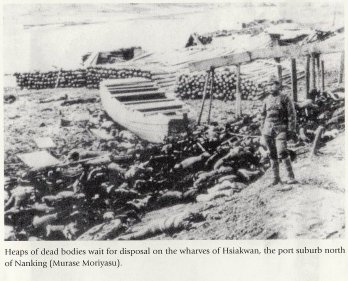 |
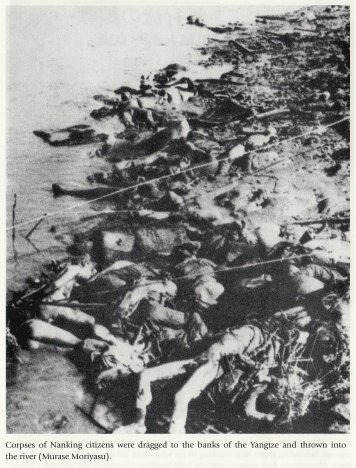 |
The caption of the Photo A describes as follows:
"Heaps of dead bodies wait for disposal on the wharves of Hsiakwan, the port suburb north of Manking (Murase Moriyasu)."
The caption of the Photo B describes as follows:
"Corpses of Nanking citizens were dragged to the banks of the Yangtze and thrown into the river (Murase Moriyasu)."
However, each of the photos taken by Murase Moriyasu iº£çÛjhas its original.
Compare the original photos below with those used in the Rape of Nanking.
|
Left: Cover of the book that contains the original photo. |
 |
 |
 |
 |
Obviously, the original photos have no captions and Iris Chang cut off the top portion of each photo.

BTW, who are the dead bodies?
When the original two photos were first released on August 16, 1983 edition of the Mainichi Simbum newspaper as the evidences of the Massacre, TAKAHASHI Yoshihiko,
who participated in the Battle of Nanking as Captain of Mountain Howitzer Company, 45th Infantry Regiment was still alive, and described that the Photo A was the result of the Battle of Shin-kou-chin iVÍÁjat Location A of Fig. 2 and the Photo B was taken at either Location A or B of the following Figure 2.
He also described the dead bodies were drifted to the place afloat, since the they are lined in one direction.
The Battle of Shin-kou-chin iVÍÁj is also called "The Battle of San-Chia-Ho (O³Íj".
On December 12, 1937 in late afternoon, Chinese forces, which lost chain of command because of early evacuation of Chiang Kai-shek and Tang Sheng-zhi, began to fall back and then flee in pell-mell in mainly three directions as illustrated in the following Figure 1.
A large body of men fled to the north of the Nanking Castle.
They encountered with Kyoto 16th Division in various places and, in pitched battles, most of them were either perished or surrendered to the division.
Another large body of men fed from Hsiakwan (Location B) to the south along the Yang-zhi River.
They encountered with 45th Infantry Regiment (6D) at the crossing with the San Cha Ho River iLocation A of Fig.2j. The rest infiltrated into the Safety Zone in civilian clothes.
Takahashi recalled:
"At about 6:00 a.m., a large body of men suddenly began attacking us with great shout banging bells and drums. This narrow strip of land between the castle wall and the river seemed to be the only escape route for them.
Therefore, the battle had become bloody and desperate. We frantically fired at them with grape-shots all at point-blank range. With one shot, nearly 100 men were cut down. We fired all shells at hand."
gI thought we won the battle when at about 11:00 a.m. I saw enemy soldiers began to strip their clothes and dive into the river. I saw groups of enemy soldiers began to create rafts tying timbers placed far behind the attacking forces. Our 15cm grape-canister howitzers fired at them with much precision observing the target by a balloon hoisted behind.
The Yang-tzi River had become a sea of blood.h
According to the battle report of the Japanese Army, the casualty of the battle is recorded as follows:
Japanese Army - dead or injured: 80
Chinese Force - dead or injured: 2,300 over the bank plus 1,000 along the river
Conclusion:
Therefore, the bodies we saw in the photos are dead soldiers.
We never claim dead soldiers are victims of a massacre.
Great numbers of soldiers died in the Battle of Iwo Jima. However, neither Japanese nor Americans consider they are the victims of a massacre.
The more you kill enemy soldiers in a battle, the more you are promoted to a higher rank.
There are no supporting evidences ever surfaced that back up the Iris Changfs claim that they are gcorpses of Nanking citizens dragged to the banks of the Yangtze and thrown into the river.h
She cut out the top portion of the photos to make the place not discernible and put the caption unrelated to the battle with malicious intent to disparage the Japanese Army.

|
To the top of this page |
 |
Return to Home
|











